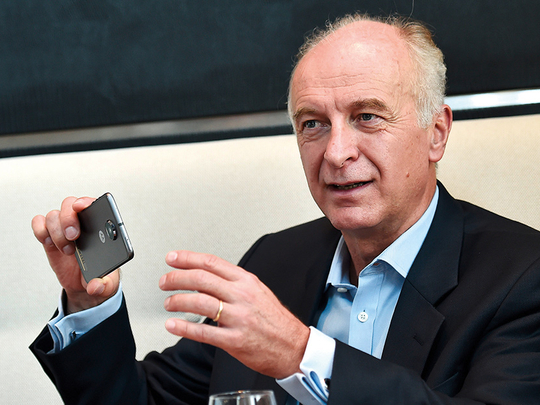
Dubai: Lenovo, which was once the number three smartphone brand worldwide (and the number two brand in China during 2014), has dropped out of the top five in just three years.
During that period Lenovo acquired Motorola for $2.91 billion (Dh10.7 billion) from Google, and now the Chinese company hopes to bounce back with its Motorola brand.
“For us to revive the brand, we need to anchor it into innovation and that is why Moto Z is so important to the brand,” Aymar de Lencquesaing, executive vice-president at Lenovo Group, chairman and president of Motorola, said in an exclusive interview with Gulf News.
Moto Z is a modular smartphone which allows users to customise hardware features such as cameras, speakers, projector and batteries and add-ons to the shell.
“Our goal is to become the number three brand in the next three to five years,” he said.
Moreover, he said the smartphone industry is experiencing a little bit of shift and change right now. The limited supplies of components are going to continue for a short term and will have an impact on the industry. It will make life difficult for some small and local players.
“The products have not evolved tremendously, in terms of technology, only marginal. It really opens up an opportunity if you are going to think out of the box. That is why our Moto Z modular smartphone has been a hit by selling 4.5 million devices in just 13 months.
“We opened up a new scope of possibilities and enabling customers to make more than just a phone. It shows that the industry still recognises innovation and values innovation,” he said.
Brand name
He said that instead of two brands — Lenovo and Motorola — the renewed focus will be on one brand: Motorola.
“Whenever we are spending a marketing dollar, we had to split it. So, we decided to launch all our brands under the Motorola brand name and we have five basic families — Z, X, G, E and the C,” he said.
Two devices under each family make for 10 devices per year and cover the whole price spectrum. So, “our average selling price has gone up”.
Lencquesaing admitted that their smartphone volumes have gone down in some markets but, at the same time, value has gone up in certain markets, expect China.
He said that Motorola has grown 137 per cent year-on-year in Western Europe last quarter ending June. In Latin America, it is number two after Samsung in major markets.
“We compete head-to-head in these markets and in India, and we win. I don’t fear that we are lacking in product innovation and in price point. It is a question of brand and building a brand. In the Middle East, we grew 13 per cent and are happy with that. Our revenues have grown 30 per cent from the region and the trends are positive,” he said.
Complex market
In rest of the world, outside of China, he said the company has grown both in volume and value. China is an extremely “complex market” because there are tier A, tier B and tier C series, broad distribution channels and multiple retail price points.
“We are re-entering the market from top end to the bottom, instead of bottom to the top. We go to the market with Motorola brand and push the volume up. In China, we are relaunching our Motorola brand and it will take time.
“We can get back into China but this is a business where you have to be humble and learn to walk before you run, one step at a time. Right now, we have less than one per cent in China,” he said.
Motorola, which was not that active in the US before one year, tied-up with all the four operators and Lencquesaing claims it is a “quantum leap”.
“You’ll see us grow by leaps and bounds in the US market,” he added.












